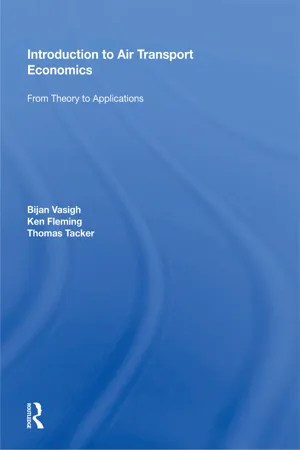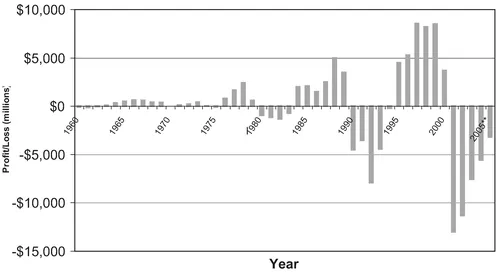
- 384 pages
- English
- ePUB (mobile friendly)
- Available on iOS & Android
eBook - ePub
About this book
Introduction to Air Transport Economics: From Theory to Applications uniquely merges the institutional and technical aspects of the aviation industry with their theoretical economic underpinnings. In one comprehensive textbook it applies economic theory to all aspects of the aviation industry, bringing together the numerous and informative articles and institutional developments that have characterized the field of airline economics in the last two decades as well as adding a number of areas original to an aviation text. Its integrative approach offers a fresh point of view that will find favor with many students of aviation. The book offers a self-contained theory and applications-oriented text for any individual intent on entering the aviation industry as a practicing professional in the management area. It will be of greatest relevance to undergraduate and graduate students interested in obtaining a more complete understanding of the economics of the aviation industry. It will also appeal to many professionals who seek an accessible and practical explanation of the underlying economic forces that shape the industry.
Frequently asked questions
Yes, you can cancel anytime from the Subscription tab in your account settings on the Perlego website. Your subscription will stay active until the end of your current billing period. Learn how to cancel your subscription.
At the moment all of our mobile-responsive ePub books are available to download via the app. Most of our PDFs are also available to download and we're working on making the final remaining ones downloadable now. Learn more here.
Perlego offers two plans: Essential and Complete
- Essential is ideal for learners and professionals who enjoy exploring a wide range of subjects. Access the Essential Library with 800,000+ trusted titles and best-sellers across business, personal growth, and the humanities. Includes unlimited reading time and Standard Read Aloud voice.
- Complete: Perfect for advanced learners and researchers needing full, unrestricted access. Unlock 1.4M+ books across hundreds of subjects, including academic and specialized titles. The Complete Plan also includes advanced features like Premium Read Aloud and Research Assistant.
We are an online textbook subscription service, where you can get access to an entire online library for less than the price of a single book per month. With over 1 million books across 1000+ topics, we’ve got you covered! Learn more here.
Look out for the read-aloud symbol on your next book to see if you can listen to it. The read-aloud tool reads text aloud for you, highlighting the text as it is being read. You can pause it, speed it up and slow it down. Learn more here.
Yes! You can use the Perlego app on both iOS or Android devices to read anytime, anywhere — even offline. Perfect for commutes or when you’re on the go.
Please note we cannot support devices running on iOS 13 and Android 7 or earlier. Learn more about using the app.
Please note we cannot support devices running on iOS 13 and Android 7 or earlier. Learn more about using the app.
Yes, you can access Introduction to Air Transport Economics by Bijan Vasigh in PDF and/or ePUB format, as well as other popular books in Business & Business General. We have over one million books available in our catalogue for you to explore.
Information
1
The Evolving Air Transport Industry
If you want to be a millionaire, start with a billion dollars and open an airline. Soon enough you will be a millionaire.
Sir Richard Branson, Founder, Virgin Atlantic Airways
As the comment above implies, in the last 30 years the airline industry’s earnings have fluctuated wildly (mostly downward). New carriers such as JetBlue and AirTran in the US, easyJet and Ryanair in Europe, Gol and Volaris in Latin America and a few others have entered the industry, but many others such as Eastern, Pan Am, and Midway have declared bankruptcy and ceased operation. The purpose of this chapter is to describe the evolution of air transport industry, including airlines and airports.1 The topics include the following:
- The airline industry
- The financial condition of the airline industry
- Airline industry consolidation
- Factors affecting world air traffic growth
- The economic impact of the air transport industry
- The outlook for the air transport industry.
The Airline Industry
People Express is clearly the archetypical deregulation success story and the most spectacular of my babies. It is the case that makes me the proudest.
Alfred Kahn, Professor of Political Economy, Cornell University, 1986
Since the US Airline Deregulation Act of 1978, the US airline industry (and, to a certain extent, the global airline industry) has been characterized by volatility. Periods of high revenues are followed by periods of economic drought. The most recent economic “trough” followed the 11 September terrorist attacks in 2001. This volatility produces airline bankruptcies, extensive layoffs or employee pay cuts, loss of shareholder wealth, and great uncertainty in the market. Prior to deregulation, the airline industry was relatively stable with minimal losses and healthy profits; however, it was also clear that this state of affairs was due mainly to government regulation that virtually eliminated any meaningful competition between airlines and certainly prevented new competitors from entering the market. The biggest loser in all of this was of course, the passenger, who had to pay ticket prices that were set to cover average airline costs with no competitive discounts permitted. Therefore, while deregulation may seemingly have caused huge financial losses, it also reflected the fact that airlines were faced with their first bout of meaningful competition and some did not measure up. On the other hand, deregulation also opened up the opportunity for some airlines, such as Southwest Airlines and Ryanair to post some of the greatest profits in the history of the industry. Figure 1.1 graphically displays this trend for the global airline industry overall.
The major reason why the deregulation of the US airline industry had such a large impact on the global airline industry is that the North American airline industry has been the most dominant aviation industry in the world. As Table 1.1 shows, the North American market currently holds the distinction of being the largest market in terms of both total passengers and aircraft movements with percentages of 36.1 per cent and 49.6 per cent, respectively. Europe, with a 30.9 per cent share of total passengers, has narrowed the gap so that the US proportion of world passengers is now much smaller than it was in the 1980s. Other aviation markets, in addition to Europe, have also emerged—in particular, the airline industries of Asia-Pacific and the Middle East.2 This growth has been a direct result of the economic expansion in those regions, particularly China and India. Furthermore,

Figure 1.1 World airline operating profits
Source: Compiled by the authors.
Source: Compiled by the authors.
Table 1.1 World airlines passenger and cargo traffic
| Region | Passengers | Passengers (%) | YTD Growth |
|---|---|---|---|
| Africa | 109,355,929 | 2.7 | 6.6 |
| Asia-Pacific | 890,903,969 | 21.8 | 9.1 |
| Europe | 1,261,931,534 | 30.9 | 7.2 |
| Latin America | 248,393,399 | 6.1 | 8.8 |
| Middle East | 97,593,687 | 2.4 | 10.7 |
| North America | 1,476,311,133 | 36.1 | 1.8 |
| Total | 4,084,489,651 | 100.00% | 5.7% |
| Region | Cargo | Cargo (%) | YTD Growth |
| Africa | 1,437,612 | 1.9 | 10.3 |
| Asia-Pacific | 25,868,817 | 33.6 | 6.9 |
| Europe | 15,795,039 | 20.5 | 2.6 |
| Latin America | 3,564,103 | 4.6 | 0.4 |
| Middle East | 3,455,683 | 4.5 | 8.7 |
| North America | 26,857,094 | 34.9 | -0.3 |
| Total | 76,978,348 | 100.0 | 3.2 |
| Region | Movements | Movements (%) | YTD Growth |
| Africa | 1,913,945 | 2.9 | 1.7 |
| Asia-Pacific | 8,290,312 | 12.5 | 6.9 |
| Europe | 17,787,273 | 26.8 | 3.3 |
| Latin America | 4,454,798 | 6.7 | 2.9 |
| Middle East | 973,146 | 1.5 | 7.6 |
| North America | 32,837,615 | 49.6 | -1.5 |
| Total | 66,257,089 | 100.0 | 1.3 |
Source: Airports Council International.
Note: Data is based on the 12 months preceding and including May 2006.
Note: Data is based on the 12 months preceding and including May 2006.
the gap will continue to narrow on the basis of the impressive growth rat...
Table of contents
- Cover
- Half Title
- Dedication
- Title
- Copyright
- Contents
- List of Figures
- List of Tables
- Acknowledgments
- List of Abbreviations
- Preface
- 1 The Evolving Air Transport Industry
- 2 Principles of Economics
- 3 Market Demand Analysis and Demand and Supply for Airline Services
- 4 Cost and Production Analysis: The General Concepts
- 5 Aviation Infrastructure: Operations and Ownership
- 6 International Economics and Aviation
- 7 International Aviation: Open Skies and Global Alliances
- 8 Market Structure-Competitive and Monopolistic Markets
- 9 Hybrid Market Structure and the Aviation Industry
- 10 Aviation Forecasting and Regression Analysis
- 11 Pricing Policy and Revenue Management
- 12 Low-cost, Start-up Airlines: A New Paradigm
- 13 The Economics of Aviation Safety and Security
- Index